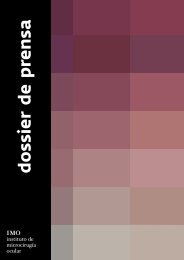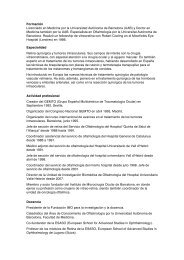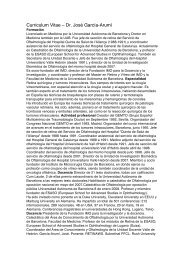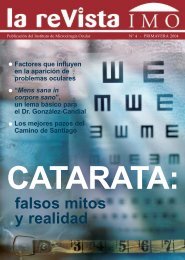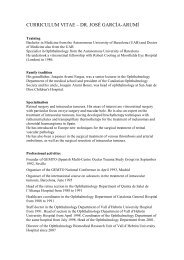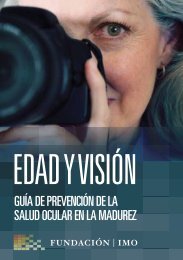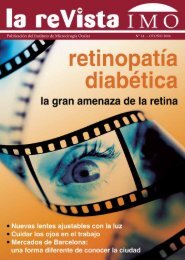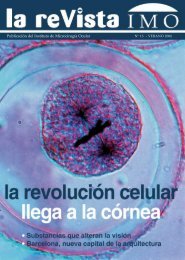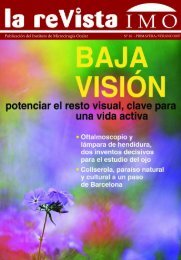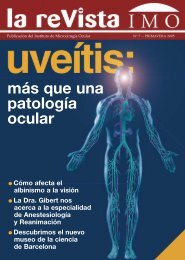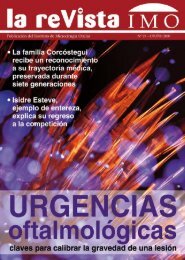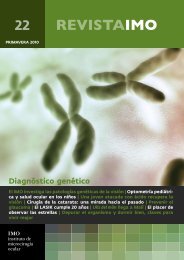FINAL PROGRAM - Imo
FINAL PROGRAM - Imo
FINAL PROGRAM - Imo
Create successful ePaper yourself
Turn your PDF publications into a flip-book with our unique Google optimized e-Paper software.
Original Papers<br />
pected retinoblastoma between 1974 and 2011, 2171 patients (78%) had<br />
retinoblastoma and 604 patients (22%) had simulating lesions. Of these 604<br />
patients, there were 27 different etiologies. The 3 most common conditions<br />
were Coats disease (244, 40%), persistent fetal vasculature (PFV) (158, 28%),<br />
and vitreous hemorrhage (27, 5%). The remainder of the patients had less<br />
common simulating conditions. Conclusion: Coats disease, PFV, and vitreous<br />
hemorrhage are the most common simulators of retinoblastoma.<br />
3:31 PM<br />
Panel discussion of previous paper<br />
Part II, 3:42 PM - 5:35 PM<br />
Moderator: John T Thompson MD<br />
Panel: Dean Eliott MD, Harry W Flynn Jr MD, K Bailey Freund MD<br />
PA056<br />
3:42 PM<br />
Combining Genotype and Phenotype to Predict Progression<br />
to Choroidal Neovascularization<br />
Presenting Author: Lorah Perlee*<br />
Co-Author(s): Aruna T Bansal PhD*, Karen Marie Gehrs MD*, Jeffrey S<br />
Heier MD*, Karl G Csaky MD*, Rando Allikmets PhD**, Paul Oeth MS**,<br />
Toni Paladino PhD*, Daniel H Farkas PHD*, Lyle Rawlings*, Gregory S<br />
Hageman PhD*<br />
Purpose: Accuracy of prediction of CNV development was evaluated in<br />
patients with AMD using a model that combined baseline disease severity<br />
and genetic burden. Methods: An analysis was performed on 2414 AREDS<br />
subjects graded at baseline (AREDS simplified severity scale), surveyed<br />
across 13 disease-associated genetic variants and evaluated based on 10-<br />
year follow-up data. Results: Allowing for variation in baseline grade, the<br />
median predicted probability of progression was 0.2% (range: 0.04%-12%) in<br />
subjects with the lowest genetic load, compared to 57% (range: 26%-99%)<br />
in subjects with the highest genetic load. Conclusion: Evaluating patient<br />
genotype in combination with baseline disease improves the accuracy of CNV<br />
prediction.<br />
3:49 PM<br />
Panel discussion of previous paper<br />
PA057<br />
3:54 PM<br />
Integrated 96-Week Results From the VIEW 1 & VIEW 2<br />
Studies: Intravitreal Aflibercept Injection in Neovascular<br />
AMD<br />
Presenting Author: Peter K Kaiser MD*<br />
On behalf of VIEW1 and VIEW2 Investigators<br />
Purpose: To assess efficacy and safety of intravitreal aflibercept (IAI) vs.<br />
ranibizumab (RBZ). Methods: Patients were randomized to RBZ 0.5 mg<br />
monthly (Rq4); IAI 2 mg monthly (2q4), 0.5 mg monthly (0.5q4), or 2 mg every<br />
2 months (2q8) after 3 loading doses. Weeks 52 to 96 patients were treated<br />
with modified quarterly dosing. Results: At Week 96, visual acuity (VA) gains<br />
were 7.9, 7.6, 6.6, and 7.6 letters, respectively. Most frequent ocular adverse<br />
events were conjunctival hemorrhage, eye pain, retinal hemorrhage, and VA<br />
reduced. Conclusion: VA improvements with IAI and RBZ at Week 52 were<br />
largely maintained through Week 96; efficacy of 2q8 IAI was similar to Rq4.<br />
4:01 PM<br />
Panel discussion of previous paper<br />
PA058<br />
4:06 PM<br />
Anatomic Correlates of Long-term Visual Outcomes in the<br />
ANCHOR/MARINA Cohort of Ranibizumab-Treated AMD<br />
Patients<br />
Presenting Author: Soraya Rofagha MD<br />
Co-Author(s): Robert B Bhisitkul MD**, David S Boyer MD*, Kang Zhang MD<br />
PhD*, Srinivas R Sadda MD*<br />
Purpose: To report long-term visual and anatomic outcomes of ranibizumabtreated<br />
exudative AMD patients from the ANCHOR/MARINA trials with carryover<br />
into the HORIZON trial. Methods: Multicenter, uncontrolled, crosssectional<br />
study. Patients were evaluated with ETDRS visual acuity, biomicroscopy,<br />
retinal imaging, and genetic analysis. Results: Fifteen sites recruited<br />
65 patients with average follow-up of 7.3 years. Thirty-seven percent of eyes<br />
were 20/70 or better. On average, eyes lost 8.6 and 19.8 letters since entry<br />
and exit from MARINA/ANCHOR, respectively; 67% had CNV on fluorescein<br />
angiography (FA) and 68% had cystoid macular edema and/or SRF on OCT.<br />
Conclusion: A minority of eyes had good visual and anatomic outcomes.<br />
Most eyes were active by FA and OCT; visual correlates suggest that close<br />
follow-up and therapeutic vigilance is necessary.<br />
4:13 PM<br />
Panel discussion of previous paper<br />
APAO PA059<br />
4:18 PM<br />
Comparison of Ranibizumab (Lucentis) and Photodynamic<br />
Therapy on Polypoidal Choroidal Vasculopathy (LAPTOP)<br />
Study<br />
Presenting Author: Akio Oishi MD PHD<br />
Co-Author(s): Hiroshi Kojima MD PhD, Michiko Mandai*, Shigeru Honda<br />
MD PHD, Toshiyuki Matsuoka MD PhD, Hideyasu Oh MD PHD, Mihori Kita,<br />
Tomoko Nagai MD, Masashi Fujihara MD PhD, Masafumi Uematsu MD,<br />
Yasuo Kurimoto MD PhD*, Akira Negi MD<br />
Purpose: To compare visual outcome between intravitreal injection of ranibizumab<br />
(IVR) and photodynamic therapy (PDT) in patients with polypoidal<br />
choroidal vasculopathy (PCV). Methods: We randomly assigned 94 patients<br />
with PCV to IVR or PDT. After 1 year of treatment protocol, the rate of visual<br />
acuity improvement or worsening as judged by 0.2 logMAR units change was<br />
compared. Results: After the exclusion of 6 patients who had dropped out,<br />
IVR and PDT groups consisted of 44 and 44 patients, respectively. Visual outcome<br />
was superior in IVR (improved: unchanged: worsened = 27%:66%:7%<br />
in IVR group and 16%:59%:25% in PDT group, P = .046). Conclusion: In<br />
PCV patients, IVR retained visual acuity better than PDT after 1 year of each<br />
treatment option.<br />
4:25 PM<br />
Panel discussion of previous paper<br />
PA060<br />
4:30 PM<br />
The Mahalo Phase 1b Study: Multidose Safety and<br />
Tolerability of FCFD4514S (Antifactor D) in Geographic<br />
Atrophy<br />
Presenting Author: David F Williams MD*<br />
Co-Author(s): Erich C Strauss MD*, Michel Friesenhahn MD*, Alice Fong<br />
PharmD*<br />
Purpose: The Phase 1b safety run-in portion of the Mahalo study evaluated<br />
safety and tolerability of multiple monthly doses of a novel antibody fragment<br />
(FCFD4514S) in geographic atrophy patients prior to initiating the Mahalo<br />
Phase 2 study. Methods: Patients received a minimum of 3 monthly 10-mg<br />
Original Papers<br />
* The presenter has a financial interest. ** The presenter has not submitted financial interest disclosure information as of press date.<br />
No asterisk indicates that the presenter has no financial interest.<br />
Up-to-date information is available in the Program Search on the Academy’s website: www.aao.org/2012.<br />
171



